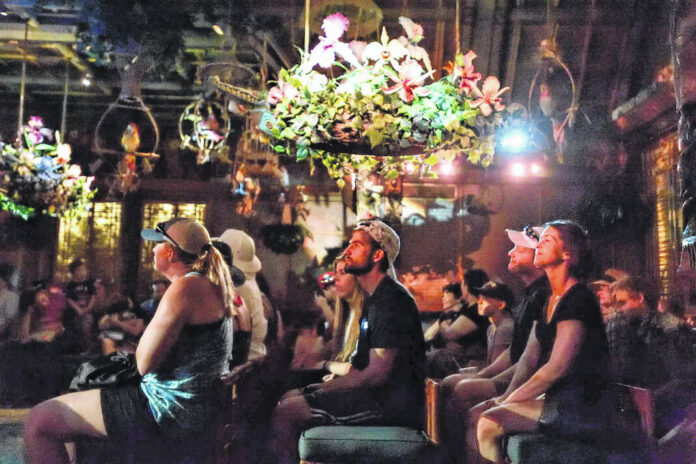ANAHEIM, Calif. — Disneyland is considered hallowed ground for fans of Tiki culture who make annual pilgrimages in Hawaiian shirts, straw hats and puka shell necklaces to sip mai tais at Trader Sam’s and visit the crowning glory of the kitsch movement — Walt Disney’s Enchanted Tiki Room.
Disneyland’s Tiki history stretches from the Enchanted Tiki Room attraction, Tahitian Terrace restaurant and Don the Beachcomber food stand to the Trader Sam’s Enchanted Tiki Bar cocktail lounge, Tropical Hideaway grab-and-go dining area and Tikiland Day annual event.
Tiki culture was born in the 1930s as U.S. travel opened to Polynesian, Caribbean, Hawaiian and South Pacific islands. Cultural appropriation spawned themed bars and Hollywood movies that tapped into Americans’ escapist fascination with the romantic and adventurous tropical settings. World War II soldiers gave the Tiki craze a boost when they returned from duty in the Pacific.
Walt Disney tapped into that tropical fever with Adventureland when Disneyland opened in 1955 with a Hollywood movie set designer’s vision of the jungle and island regions of the world. Nearly 70 years later, fans of the whimsical trappings of Tiki culture are still drawn to Adventureland and the odes to a bygone era that continue to stir up nostalgic yearnings.
The annual Tikiland Day returning to Disneyland on Sept. 10 celebrates the fun, fashion and art of all things Tiki. Tikiland Day is an off-shoot of Adventureland Day — another unofficial Disneyland event that draws like-minded fans of tropical attire, cocktails and escapism.
The 1963 Enchanted Tiki Room show was the first Disneyland attraction to feature audio-animatronic animated figures created by WED Enterprises, the precursor to Walt Disney Imagineering.
The late Imagineer Rolly Crump — who hand-carved the Tiki mask sculptures for Disneyland’s Tiki Room — remains the revered patron saint of the Tiki culture community and fans of the kitschy South Pacific design.
Crump recounted the birth of the Tiki Room in the Disney+ documentary “The Imagineering Story” and told a decidedly un-Disney story about Walt’s colorful concerns about early plans that conceived of the bird show as a restaurant.
“Walt always wanted a tea room, but instead we’re going to do a little restaurant,” Crump said in the Disney+ documentary. “John Hench was asked to do a rendering and in there he had birds in cages. Walt took one look at it and said, ‘John, you can’t have birds in cages.’ John says, ‘Why not?’ Walt says, ‘Because they’ll poop in the food.’ That’s exactly what he said. We all cracked up. John said, ‘No, no, no. Maybe they’re little mechanical birds.’ And Walt said, ‘Oh, little mechanical birds.’ And that’s how it all got started.”
While Disneyland still operates an original version of the Enchanted Tiki Room, other Disney parks have not treated the audio-animatronic bird attraction with as much reverence.
For a decade or so in Florida, the Tiki Room at Disney World’s Magic Kingdom was put under the new management of Iago and Zazu, the wisecracking birds from “Aladdin” and “The Lion King.” Tokyo Disneyland has treated the beloved singing bird show even worse, adding a Las Vegas nightclub theme to the Tiki Room in 1999 and a Hawaiian “Lilo and Stitch” overlay in 2008.
The Trader Sam’s Enchanted Tiki Bar became an instant hit when it opened in 2011 at the Disneyland Hotel. The Imagineering-designed Tiki bar includes nods to Disney films and features audio-animatronics along with lighting, sound and special effects. The bar’s lineup of limited edition Tiki mugs often draws long lines of the faithful who rave about the collectible designs.
Next door to Trader Sam’s is the Tangaroa Terrace bar and grill with Tiki torches, tropical music and a South Seas menu with a Polynesian twist.
A second Trader Sam’s opened in 2015 in Florida at the Tiki-inspired Polynesian Village resort hotel that debuted in 1971 at Walt Disney World.
The Trader Sam’s bars take their names from the culturally insensitive Jungle Cruise headhunter character that was removed from the Disneyland river boat attraction in 2021.
Trader Sam’s Enchanted Tiki Bar owes a debt to Don the Beachcomber in Hollywood and Trader Vic’s in Oakland — the rival Tiki bars that gave birth to the pop culture movement in the mid-1930s and both lay claim to creating the mai tai cocktail.
The short-lived Hollywood & Dine food court that opened in 2001 with Disney California Adventure in Soundstage 12 of Hollywood Land included a food stand called Don the Beachcomber. The Chinese take-out eatery featured a dining area themed to look like a Tiki lounge with bamboo, oars, totems and puffer fish lamps.
Disneyland opened the Tropical Hideaway grab-and-go dining area in 2018 between the Tiki Room and Jungle Cruise in the tight confines of Adventureland. Diners can nosh on a menu of lumpia, bao buns and ramen while sipping Dole Whips under the glow of tiki torches and chatting with an animatronic bird.
The Tropical Hideaway helps take some of the pressure off of the always-crowded Dole Whip stand in front of the Tiki Room at the entrance to Adventureland — and offers a few additional flavors that can be swirled with the traditional pineapple soft serve.
Tropical Hideaway occupies the former location of Tahitian Terrace — another temple of Tiki culture that operated in Adventureland from 1962 to 1993. The Tahitian Terrace dinner theater offered dishes from Tahiti, Samoa and Hawaii along with a stage show featuring fire walkers and hula dancers.







